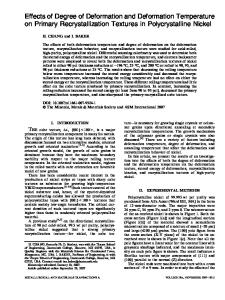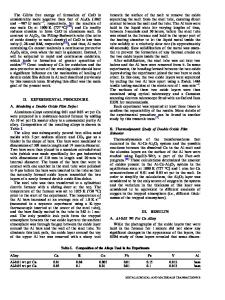Deformation and recrystallization textures in commercially pure aluminum
- PDF / 732,079 Bytes
- 7 Pages / 594 x 774 pts Page_size
- 44 Downloads / 332 Views
I.
INTRODUCTION
THE microstructural development during deformation and recrystallization of commercially pure aluminum have been studied in detail (See References 1 and 2). The main parameters varied in those studies were the initial grain size and the degree of deformation prior to recrystallization (15 to 90 pet reduction by cold-rolling). These studies have given information about processes such as formation and growth of recrystallization nuclei in a metal containing large intermetallic particles which can act as nucleation sites. Additional and complementary information of a more macroscopic nature may, however, be obtained by quantitative texture measurements which have been performed in the present study by neutron diffraction. In order to correlate the microstructural and textural information, the material and the type and degree of cold deformation were chosen to be practically the same as in the previous studies, t,2 II.
EXPERIMENTAL TECHNIQUES
A. Sample Preparation The chemical composition of the aluminum used is given in Table I. The material is slightly purer (99.6 pet) than that used previously (99.4 pct); 1'2however, the iron/silicon ratio is practically the same. To reduce the amount of iron in supersaturated solution, the starting material was heat treated at 600 ~ in high vacuum followed by slow cooling in the furnace. Fine-grained material was produced by 50 pct cold-rolling followed by annealing for one hour at 350 ~ Coarse-grained material was produced by 20 pct cold-rolling followed by annealing for one hour at 400 ~ These treatments gave practically identical textures in the fine- and coarse-grained specimens. The grain sizes obtained were approximately 50 and 350/xm which are somewhat larger than those studied earlier (24 and 290/xm).~'2 The final cold deformations prior to the recrystallization NIELS HANSEN, Head, MetallurgyDepartment, and DORTE JUUL JENSEN, Research Scientist, are with Rise National Laboratory,Metallurgy Department, P.O. Box 49, DK-4000 Roskilde, Denmark. Manuscript submittedMarch 25, 1985. METALLURGICALTRANSACTIONSA
treatments were 15, 30, 50, 90, and 95 pet reduction in thickness by cold-rolling. The material contained large plate-shaped intermetallic FeA13 particles which have an aspect ratio (diameter to thickness) in the range one to eight. The mean size and the size range of the particles are given in Table I. The specimens for the texture measurements were discs of a diameter of 15 mm stamped out of the cold-rolled plates. The surface of the discs was removed by etching for 60 seconds in NaOH, and the discs were stacked to form a cylindrical composite specimen. The total height of the specimens was in the range 5 to 10 mm. The specimens were isothermally annealed in a furnace attached to the neutron spectrometer, and recrystallization temperatures in the range 240 to 440 ~ were applied. In order to supplement the previous investigations some annealed specimens were investigated microscopically to determine the orientation of newly formed recrystallization nucle
Data Loading...










